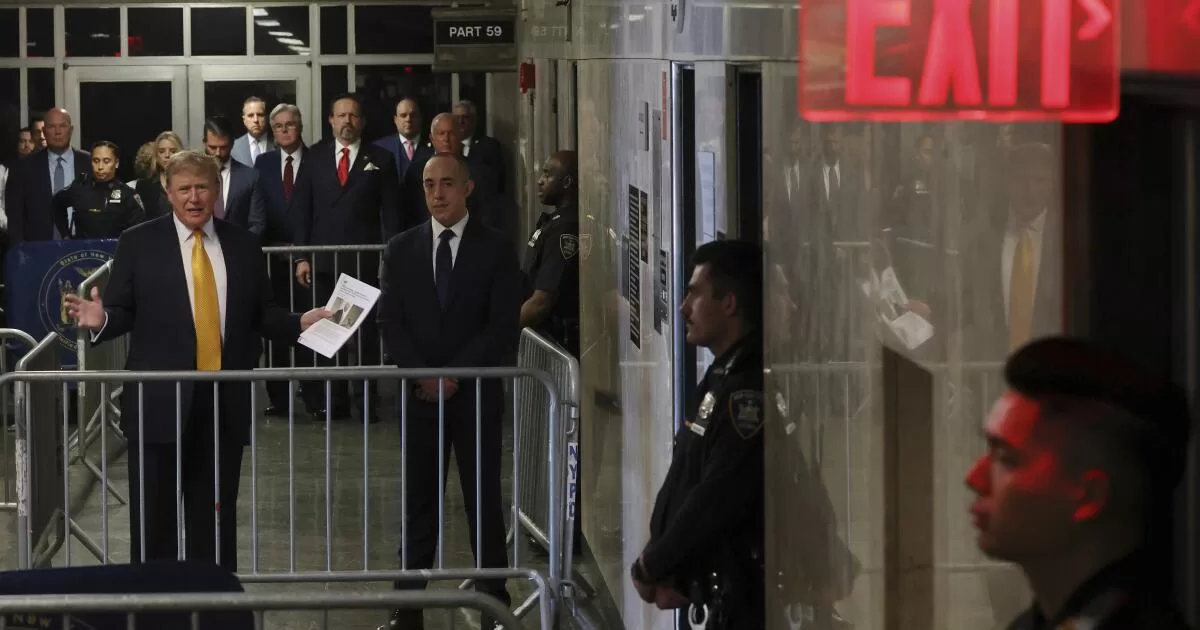Who holds the advantage at this critical juncture? My assessment, after attending much of the trial in person, is that it’s the prosecution’s case to lose.
With the standing caveat that it takes only one juror to block a unanimous guilty verdict — and that the law puts the greatest burden on prosecutors — the case as it has come in puts the district attorney’s office in the driver’s seat going into next week’s closing arguments.
The prosecution’s essential achievement was to provide a compelling, credible narrative that points toward only one plausible conclusion: that Trump is guilty as charged.
The defense, by contrast, took a scattershot approach focused on undermining the credibility of any and all of the prosecution’s witnesses, particularly Michael Cohen, Trump’s former attorney and fixer. But what Trump’s lawyers didn’t do is provide a counternarrative, a story compelling enough to leave jurors with a reasonable doubt as to which explanation of the facts is true.
Providing such a competing story isn’t the defense’s legal obligation, of course. The judge will instruct the jurors that if they have any reasonable doubt about the prosecution’s case, they should vote to acquit.
But my experience as a trial lawyer suggests a difference between freestanding doubt about one or more witnesses and a broader doubt about the rationale behind the charges — an alternative plotline that jurors might find believable. That’s the kind of defense being presented on behalf of Sen. Robert Menendez, for example, who is arguing that his wife is the guilty party.
From the first day of testimony, the prosecution has presented a tight, persuasive tale. It begins with an August 2015 meeting involving Trump, Cohen and tabloid executive David Pecker — who explained it to the jury from the stand — in which the parties agreed on a scheme to smother negative stories about Trump.
And sure enough, before the next year’s election, a series of scandal-mongers required neutralizing to insulate Trump from political damage. These episodes are akin to Acts II and III of the script, falling into place along the tracks that the Pecker testimony laid.
Hope Hicks’ testimony was brief but powerful given her longtime loyal service to Trump and her obvious candor notwithstanding her reluctance to harm her former boss, which seemed to cause her to break into tears. She confirmed in dramatic terms that Cohen and Allen Weisselberg, the Trump Organization’s then-chief financial officer, would not have cooked up the scheme to pay off the adult-film actor Stormy Daniels without Trump’s say-so.
The prosecution effectively corroborated in advance most of what would come from its last and most important witness, Cohen. At the same time, the prosecutors encouraged their own witnesses to disparage Cohen, lowering expectations before he took the stand.
When he did, Cohen was low-key, responsive and agreeable. With a few exceptions, he accepted the insults the defense served up, accounting for most of the discrepancies in his story by explaining that he had been telling the truth since he left the Trump fold.
A couple of low points in Cohen’s testimony got a lot of attention, and it’s natural for the media to zero in on dramatic moments. But the jury is more likely to evaluate the evidence in the context of the whole narrative and a witness’ general comportment.
Most important, jurors, like all of us, make overall judgments about credibility, which is the heart and soul of the jury system. Taking the measure of the people before them, they decide whether their accounts are basically trustworthy, notwithstanding the defects of the messengers. And all the stories in this case — not just Cohen’s but those of other flawed witnesses such as Pecker and Daniels — cohere and ring true.
It follows that the impertinence of Robert Costello, a defense witness who muttered in disagreement with Judge Juan M. Merchan’s rulings, probably caught the jury’s attention more than the flaws in Cohen’s largely even presentation — especially once Merchan forcefully rebuked Costello’s buffoonish grandstanding.
The prosecution’s cross-examination of Costello and redirect of both Cohen and Daniels were crisp, clear, textbook demolitions of the defense’s points. Trump’s team was more meandering and given to stray potshots, missing more than they hit.
I think the defense still has one largely overlooked escape hatch: the arcane legal instructions for deciding the felony charges. The charges require the prosecution to prove that Trump caused the alleged falsification of documents to further another crime. Prosecutors have offered up three different candidates for that other crime, each of which has flaws. I could see the jury, which includes two lawyers, considering the legal instructions very carefully and finding that the district attorney came up short. And in any event, the issue is sure to figure in an appeal.
But any appeal feels a millennium away. By the time that transpires, Trump will either be president, giving him extensive options for evading accountability, or a losing candidate facing three other criminal trials. This trial looks increasingly likely to be the only opportunity for a jury to decide for the first time whether a former president is a criminal. Going into the final act, I like the chances that he will be found guilty.
Harry Litman is the host of the “Talking Feds” podcast and the Talking San Diego speaker series. @harrylitman
